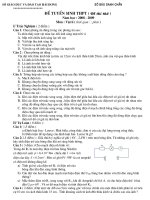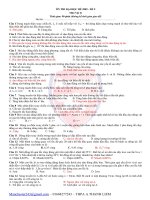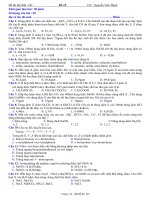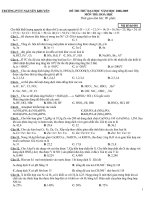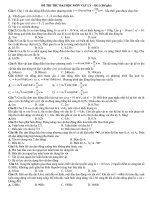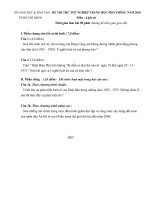- Trang chủ >>
- THPT Quốc Gia >>
- Ngoại Ngữ
DE THI THU THPT l5
Bạn đang xem bản rút gọn của tài liệu. Xem và tải ngay bản đầy đủ của tài liệu tại đây (127.13 KB, 13 trang )
ĐỀ THI THỬ THPTQG (L5)
Mark the letter A, B, C, or D on your answer sheet to indicate the word whose underlined part
differs from the other three in pronunciation in each of the following questions.
Question 1: A. change B. champagne
C. channel
D. choice
Question 2: A. cities
B. areas
C. envelops
D. days
Mark the letter A, B, C, or D on you answer sheet to indicate the word that differs from the
rest in the position of the main stress in each of the following questions.
Question 3: A. ornamental B. computer
C. courageous
D. industrial
Question 4: A. identity B. modernize
C. impressive
D. emotion
Mark the letter A, B, C, or D on your answer sheet to indicate the correct answer to each of
the following questions.
Question5: Some snakes lay eggs, but
give birth to live offspring.
A. other
B. the other
C. others
D. the others
Question 6: I
Katie, an old friend of mine, on the way home from work yesterday.
B. came into
B. ran into
C. call off
D. get into
Question 7: I haven’t read any medical books or articles on the subject for a long time, so I’m
______ with recent developments.
A. out of reach
B. out of the condition
C. out of touch
D. out of the question
Question 8: Kate didn’t enjoy the roller coaster ride because it was _____ experience of her life.
A. the most terrifying
B. the most terrified
C. a most terrified
D. far more terrifying
Question 9: I assume that you are acquainted ______ this subject since you are responsible
______ writing the accompanying materials.
A. to/for
B. with/for
C. to/to
D. with/with
Question 10: Everyone in both cars ______ injured in the accident last night, ?
A. was/weren’t they B. were/ weren’t they C. was/ wasn’t he
D. were/ were they
Question 11: When the Titanic started sinking, the passengers were ______.
A. horrifying
B. apprehensive
C. panic-stricken
D. weather-beaten
Question 12: Jack has a collection of ______.
A. old valuable Japanese postage stamps
B. old Japanese valuable postage stamps
C. valuable Japanese old postage stamps
D. valuable old Japanese postage stamps
Question 13: By appearing on the soap powder commercials, she became a ______ name.
A. housekeeper
B. housewife
C. household
D. house
Question 14:- Jenny: “Was Linda asleep when you came home?”
-Jack: “No. She ______ TV.”
A. watched
B. had watched
C. was watching
D. has been watching
Question 15: This class, ______ is a prerequisite for microbiology, is so difficult that I would
rather drop it.
A. that
B. when
C. where
D. which
Question 16: During the campaign when Lincoln was first a(n) ______ for the Presidency, the
slaves on the far-off plantations, miles from any railroad or large city or daily newspaper, knew
what the issues involved were.
A. competitor
B. contestant
C. applicant
D. candidate
Question 17: -Peter: “What ______ your flight?”
-Mary: “There was a big snowstorm in Birmingham that delayed a lot of flights.”
A. held up
B. postponed up
C. delayed up
D. hung up
Question 18: ______ his poor English, he managed to communicate his problem very clearly.
A. Because
B. Even though
C. Because of
D. In spite of
Mark the letter A, B, C, or D on your answer sheet to indicate the most suitable response to
complete each of the following exchanges.
Question 19: Jane is talking to Billy about the meeting.
-Jane: “Is everybody happy with the decision?”.
-Billy: “______”.
A. That sounds like fun.
B. Yes, it is certainly.
C. No, have you?
D. Not really.
Question 20: Lucy is asking for permission to play the guitar at Pete’s home.
-Lucy: “Is it all right if I play the guitar in here while you’re studying?”.
-Pete: “______”.
A. Oh, I wish you wouldn’t.
B. Well, I’d rather not.
C. Well, actually, I’d prefer it if you didn’t.
D. Well, if only you didn’t.
Mark the letter A, B, C, or D on your answer sheet to indicate the word(s) OPPOSITE in
meaning to the underlined word(s) in each of the following questions.
Question 21: Nutritionists believe that vitamins circumvent diseases.
A. defeat
B. nourish
C. help
D. treat
Question 22: Adverse weather conditions made it difficult to play the game.
A. favorable
B. bad
C. comfortable
D. severe
Mark the letter A, B, C, or D on your answer sheet to indicate the sentence that is closest in
meaning to each of the following questions.
Question 23: "I have never been to Russia. I think I shall go there next year.” said Bill.
A. Bill said that he had never been to Russia and he thought he would go there the next year.
B. Bill said that he would have never been to Russia and he thinks he would go there the next
year.
C. Bill said that he had never been to Russia and he thinks he will go there the next year.
D. Bill said that he has never been to Russia and he thinks he would go there the next year.
Question 24: People believed that Jane retired because of her poor health.
A. Jane is believed to have retired because of her poor health.
B. Jane was believed to have retired because of her poor health.
C. It is believed that Jane retired because of her poor health.
D. Jane retired because of her poor health was believed.
Question 25: Charles would have won the essay contest if he had typed his paper.
A. Charles won the essay contest in spite of not typing his paper.
B. Charles did not win the essay contest because he did not type his paper.
C. Typing his paper made Charles win the essay contest.
D. Charles did not win the essay contest even though he typed his paper.
Read the following passage and mark the letter A, B, C, or D on your answer sheet to indicate
the correct answer to each of the questions from 24 to 30.
Duncan Phyfe made some of the most beautiful furniture found in America. His family name
was originally Fife, and he was born in Scotland in 1768. In 1784, the Fife family immigrated to
Albany, New York where Duncan’s father opened a cabinetmaking shop. Duncan followed his
father’s footsteps and was apprenticed to a cabinetmaker. After completing his training, Duncan
moved to New York City.
Duncan Fife was first mentioned in the 1792 NYC Directory as a furniture “joiner” in
business at 2 Broad Street. Two years later, he moved, expanded his business, and changed his
name to Phyfe. He was a quiet-living, God-fearing young man who felt his new name would
probably appeal to potential customers who were definitely anti-British in this postRevolutionary War period.
Duncan Phyfe’s name distinguished him from his contemporaries. Although the new spelling
helped him better compete with French emigrant craftsmen, his new name had more to do with
hanging it on a sign over his door stoop.
The artisans and merchants who came to America discovered a unique kind of freedom. They
were no longer restricted by class and guild traditions of Europe. For the first time in history, a
man learned that by working hard, he could build his business based on his own name and
reputation and quality of work.
Phyfe’s workshop apparently took off immediately. At the peak of his success, Phyfe
employed 100 craftsmen. Some economic historians point to Phyfe as having employed division
of labor and an assembly line. What his workshop produced shows Phyfe’s absolute dedication
to quality in workmanship. Each piece of furniture was made of the best available materials. He
was reported to have paid $1,000 for a single Santo Domingo mahogany log.
Phyfe did not create new designs. Rather, he borrowed from a broad range of the period’s
classical styles, Empire, Sheraton, Regency, and French Classical among them. Nevertheless,
Phyfe’s high quality craftsmanship established him as America’s patriotic interpreter of European
design in the late eighteenth and early nineteenth centuries.
Although the number of pieces produced by Duncan Phyfe’s workshop is enormous,
comparatively few marked or labeled pieces have been found extant. In antiques shops and
auctions, collectors have paid $11,000 for a card table, $24,200 for a tea table, and $93,500 for a
sewing table.
Question 26: What is the main idea of the passage?
A. The business of cabinetmaking.
B. The significance of Duncan Phyfe’s name.
C. Duncan Phyfe’s life and career.
D. Duncan Phyfe’s cabinetmaking designs.
Question 27: Which choice does the word “it” in paragraph 3 refer to?
A. His spelling
B. His chair
C. His French
D. His name
Question 28: Which choice is closest in meaning to the word “guild” in paragraph 4?
A. Verdict of a jury
B. Organization of craftsmen
C. Political party of emigrants
D. Immigrants’ club
Question 29: In his business, Duncan Phyfe used all of the following EXCEPT ______.
A. division of labor
B. an assembly line
C. continental designs
D. the least expensive materials
Question 30: Based on the information in the passage, what can be inferred about Duncan
Phyfe’s death?
A. He died in the eighteenth century.
B. He died in Albany.
C. He died in the nineteenth century.
D. He died in Scotland.
Question 31: The author implies that ______.
A. furniture from Duncan Phyfe’s workshop no longer exists.
B. furniture from Duncan Phyfe’s workshop costs a lot of money today.
C. furniture from Duncan Phyfe’s workshop was ignored by New Yorkers.
D. furniture from Duncan Phyfe’s workshop was made by his father.
Read the following passage and mark the letter A, B, C or D on your answer sheet to indicate
the correct word or phrase that best fits each of the numbered blanks from 31 to 35.
A rainbow is an optical display of color that usually appears in the sky when a beam of
sunlight refracts through millions of raindrops. Each (32) ______ color from the spectrum is then
sent to your eyes. For this to happen, the angle between the ray of light, the raindrop and the
human eye must be between 40 and 42 degrees.
After studying rainbows in (33) ______, Sir Isaac Newton was able to explain how they are
formed. However, he was color blind, so he had to rely on the eyes of his assistant, who could
easily (34) ______ all the seven colors: red, orange, yellow, green, blue, indigo and violet. His
assistant could also clearly tell the difference between indigo and violet.
There are two types of rainbows. Primary rainbows are the most common and have the most
distinctive colors, with red appearing on the outside of the arc and violet on the inside.
Secondary rainbows are unusual because the light is reflected twice within the raindrop before it
(35) ______ a rainbow, so the colors are in reverse order and not as bright as primary rainbows.
There is a popular myth that if you reach the end of a rainbow, you will find a pot of gold
waiting for you. In fact, it is impossible to do this, because a rainbow has no end - as you go
towards the point where the rainbow seems to touch the ground, it moves away from you as
quickly as you (36) ______.
Question 32: A. single B. divided
C. detached
D. separate
Question 33: A. depth
B. width
C. breadth
D. length
Question 34: A. realize B. discover
C. understand
D. recognize
Question 35: A. forms B. grows
C. develops
D. shapes
Question 36: A. progress B. arrive
C. get
D. approach
Mark the letter A, B, C, or D on your answer sheet to indicate the word(s) CLOSEST in
meaning to the underlined word(s) in each of the following questions.
Question 37: Laws on military service since 1960 still hold good.
A. remains for good
B. is still in good condition
C. stands in life
D. remains in effect
Question 38: The expression “out of the frying pan and into the fire” means to go from one
dilemma to a worse one.
A. situation
B. predicament
C. solution
D. embarrassment
Mark the letter A, B, C, or D on your answer sheet to indicate the sentence that best combines
each pair of sentences in the following questions.
Question 39: The government knows the extent of the problem. The government needs to take
action soon.
A. The government knows the extent of the problem whereas it needs to take action soon.
B. The government knows the extent of the problem so that it needs to take action soon.
C. Knowing the extent of the problem, the government needs to take action soon.
D. The government knows the extent of the problem, or else it needs to take action soon.
Question 40: The substance is very toxic. Protective clothing must be worn at all times.
A. Since the substance is very toxic, so protective clothing must be worn at all times.
B. So toxic is the substance that protective clothing must be worn at all times.
C. The substance is such toxic that protective clothing must be worn at all times.
D. The substance is too toxic to wear protective clothing at all times.
Mark the letter A, B, C, or D on your answer sheet to show the underlined part that needs
correction in each of the following questions.
Question 41: (A) Once you have finished an article and (B) identified its main ideas, it may not
(C) be necessary to reread it (D) again.
Question 42: An ambitious person (A) is committed to (B) improve his or her (C) status (D) at
work.
Question 43: (A) Generally, Europe and Asia (B) are regarded as being distinct continents, but
they are simply (C) vast geography divisions of the larger lad mass (D) known as Eurasia.
Read the following passage and mark the letter A, B, C, or D on your answer sheet to indicate
the correct answer to each of the questions from 43 to 50.
After the United States purchased Louisiana from France and made it their newest territory in
1803, President Thomas Jefferson called for an expedition to investigate the land the United
States had bought for $15 million. Jefferson’s secretary, Meriwether Lewis, a woodsman and a
hunter from childhood, persuaded the president to let him lead this expedition. Lewis recruited
Army officer William Clark to be his co-commander. The Lewis and Clark expedition led the
two young explorers to discover a new natural wealth of variety and abundance about which they
would return to tell the world.
When Lewis and Clark departed from St. Louis in 1804, they had twenty-nine in their party,
including a few Frenchmen and several men from Kentucky who were well-known frontiersmen.
Along the way, they picked up an interpreter named Toussant Charbonneau and his Native
American wife, Sacajawea, the Shoshoni “Bird Woman” who aided them as guide and
peacemaker and later became an American legend.
The expedition followed the Missouri River to its source, made a long portage overland
though the Rocky Mountains, and descended the Columbia River to the Pacific Ocean. On the
journey, they encountered peaceful Otos, whom they befriended, and hostile Teton Sioux, who
demanded tribute from all traders. They also met Shoshoni, who welcomed their little sister
Sacajawea, who had been abducted as a child by the Mandans. They discovered a paradise full of
giant buffalo herds and elk and antelope so innocent of human contact that they tamely
approached the men. The explorers also found a hell blighted by mosquitoes and winters harsher
than anyone could reasonably hope to survive. They became desperately lost, then found their
way again. Lewis and Clark kept detailed journals of the expedition, cataloging a dazzling array
of new plants and animals, and even unearthing the bones of a forty-five-foot dinosaur.
When the party returned to St. Louis in 1806 after travelling almost 8,000 miles, they were
eagerly greeted and grandly entertained. Their glowing descriptions of this vast new West
provided a boon to the westward migration now becoming a permanent part of American life.
The journals written by Lewis and Clark are still widely read today.
Question 44: The purpose of the Lewis and Clark expedition was ______.
A. to establish trade with the Otos and Teton Sioux.
B. to explore territory purchased by the United States.
C. to purchase land from France.
D. to find the source of the Missouri River.
Question 45: Where in the passage does the author mention hardship faced by the expedition?
A. Lines 4-6 B.
Lines 8-10 C.
Lines 12-13
D. Lines 16-17
Question 46: The word “they” in paragraph 3 refers to ______.
A. elk and antelope
B. buffalo herds
C. the members of the expedition
D. Shoshoni and Mandans
Question 47: The word “blighted” in paragraph 3 is closest in meaning to ______.
A. increased
B. ruined
C. swollen
D. driven
Question 48: Lewis and Clark encountered all of the following EXCEPT ______.
A. mountains
B. buffaloes
C. dinosaur herds
D. friendly people
Question 49: The word “boon” in paragraph 5 is closest in meaning to ______.
A. power
B. hurdle
C. benefit
D. conclusion
Question 50: It can be inferred from the passage that the Lewis and Clark expedition ______.
A. experienced more hardships than successes.
B. encouraged Americans to move to the West.
C. probably cost the United States more than $15 million.
D. caused the deaths of some of the explorers.
--- THE END ---
ĐỀ THI THỬ THPTQG (L5)
Mark the letter A, B, C, or D on your answer sheet to indicate the word whose underlined part
differs from the other three in pronunciation in each of the following questions.
Question 1: A. change B. champagne
C. channel
D. choice
Question 2: A. cities
B. areas
C. envelops
D. days
Mark the letter A, B, C, or D on you answer sheet to indicate the word that differs from the
rest in the position of the main stress in each of the following questions.
Question 3: A. ornamental B. computer
C. courageous
D. industrial
Question 4: A. identity B. modernize
C. impressive
D. emotion
Mark the letter A, B, C, or D on your answer sheet to indicate the correct answer to each of
the following questions.
Question5: Some snakes lay eggs, but
give birth to live offspring.
C. other B. the other
C. others
D. the others
Question 6: I
Katie, an old friend of mine, on the way home from work yesterday.
D. came into
B. ran into
C. call off
D. get into
Question 7: I haven’t read any medical books or articles on the subject for a long time, so I’m
______ with recent developments.
A. out of reach
B. out of the condition
C. out of touch
D. out of the question
Question 8: Kate didn’t enjoy the roller coaster ride because it was _____ experience of her life.
A. the most terrifying
B. the most terrified
C. a most terrified
D. far more terrifying
Question 9: I assume that you are acquainted ______ this subject since you are responsible
______ writing the accompanying materials.
A. to/for
B. with/for
C. to/to
D. with/with
Question 10: Everyone in both cars ______ injured in the accident last night, ?
A. was/weren’t they B. were/ weren’t they C. was/ wasn’t he
D. were/ were they
Question 11: When the Titanic started sinking, the passengers were ______.
A. horrifying
B. apprehensive
C. panic-stricken
D. weather-beaten
Question 12: Jack has a collection of ______.
A. old valuable Japanese postage stamps
B. old Japanese valuable postage stamps
C. valuable Japanese old postage stamps
D. valuable old Japanese postage stamps
Question 13: By appearing on the soap powder commercials, she became a ______ name.
A. housekeeper
B. housewife
C. household
D. house
Question 14:- Jenny: “Was Linda asleep when you came home?”
-Jack: “No. She ______ TV.”
A. watched
B. had watched
C. was watching
D. has been watching
Question 15: This class, ______ is a prerequisite for microbiology, is so difficult that I would
rather drop it.
A. that
B. when
C. where
D. which
Question 16: During the campaign when Lincoln was first a(n) ______ for the Presidency, the
slaves on the far-off plantations, miles from any railroad or large city or daily newspaper, knew
what the issues involved were.
A. competitor
B. contestant
C. applicant
D. candidate
Question 17: -Peter: “What ______ your flight?”
-Mary: “There was a big snowstorm in Birmingham that delayed a lot of flights.”
A. held up
B. postponed up
C. delayed up
D. hung up
Question 18: ______ his poor English, he managed to communicate his problem very clearly.
A. Because
B. Even though
C. Because of
D. In spite of
Mark the letter A, B, C, or D on your answer sheet to indicate the most suitable response to
complete each of the following exchanges.
Question 19: Jane is talking to Billy about the meeting.
-Jane: “Is everybody happy with the decision?”.
-Billy: “______”.
A. That sounds like fun.
B. Yes, it is certainly.
C. No, have you?
D. Not really.
Question 20: Lucy is asking for permission to play the guitar at Pete’s home.
-Lucy: “Is it all right if I play the guitar in here while you’re studying?”.
-Pete: “______”.
A. Oh, I wish you wouldn’t.
B. Well, I’d rather not.
C. Well, actually, I’d prefer it if you didn’t.
D. Well, if only you didn’t.
Mark the letter A, B, C, or D on your answer sheet to indicate the word(s) OPPOSITE in
meaning to the underlined word(s) in each of the following questions.
Question 21: Nutritionists believe that vitamins circumvent diseases.
A. defeat
B. nourish
C. help
D. treat
Question 22: Adverse weather conditions made it difficult to play the game.
A. favorable
B. bad
C. comfortable
D. severe
Mark the letter A, B, C, or D on your answer sheet to indicate the sentence that is closest in
meaning to each of the following questions.
Question 23: "I have never been to Russia. I think I shall go there next year.” said Bill.
A. Bill said that he had never been to Russia and he thought he would go there the next year.
B. Bill said that he would have never been to Russia and he thinks he would go there the next
year.
C. Bill said that he had never been to Russia and he thinks he will go there the next year.
D. Bill said that he has never been to Russia and he thinks he would go there the next year.
Question 24: People believed that Jane retired because of her poor health.
A. Jane is believed to have retired because of her poor health.
B. Jane was believed to have retired because of her poor health.
C. It is believed that Jane retired because of her poor health.
D. Jane retired because of her poor health was believed.
Question 25: Charles would have won the essay contest if he had typed his paper.
A. Charles won the essay contest in spite of not typing his paper.
B. Charles did not win the essay contest because he did not type his paper.
C. Typing his paper made Charles win the essay contest.
D. Charles did not win the essay contest even though he typed his paper.
Read the following passage and mark the letter A, B, C, or D on your answer sheet to indicate
the correct answer to each of the questions from 24 to 30.
Duncan Phyfe made some of the most beautiful furniture found in America. His family name
was originally Fife, and he was born in Scotland in 1768. In 1784, the Fife family immigrated to
Albany, New York where Duncan’s father opened a cabinetmaking shop. Duncan followed his
father’s footsteps and was apprenticed to a cabinetmaker. After completing his training, Duncan
moved to New York City.
Duncan Fife was first mentioned in the 1792 NYC Directory as a furniture “joiner” in
business at 2 Broad Street. Two years later, he moved, expanded his business, and changed his
name to Phyfe. He was a quiet-living, God-fearing young man who felt his new name would
probably appeal to potential customers who were definitely anti-British in this postRevolutionary War period.
Duncan Phyfe’s name distinguished him from his contemporaries. Although the new spelling
helped him better compete with French emigrant craftsmen, his new name had more to do with
hanging it on a sign over his door stoop.
The artisans and merchants who came to America discovered a unique kind of freedom. They
were no longer restricted by class and guild traditions of Europe. For the first time in history, a
man learned that by working hard, he could build his business based on his own name and
reputation and quality of work.
Phyfe’s workshop apparently took off immediately. At the peak of his success, Phyfe
employed 100 craftsmen. Some economic historians point to Phyfe as having employed division
of labor and an assembly line. What his workshop produced shows Phyfe’s absolute dedication
to quality in workmanship. Each piece of furniture was made of the best available materials. He
was reported to have paid $1,000 for a single Santo Domingo mahogany log.
Phyfe did not create new designs. Rather, he borrowed from a broad range of the period’s
classical styles, Empire, Sheraton, Regency, and French Classical among them. Nevertheless,
Phyfe’s high quality craftsmanship established him as America’s patriotic interpreter of European
design in the late eighteenth and early nineteenth centuries.
Although the number of pieces produced by Duncan Phyfe’s workshop is enormous,
comparatively few marked or labeled pieces have been found extant. In antiques shops and
auctions, collectors have paid $11,000 for a card table, $24,200 for a tea table, and $93,500 for a
sewing table.
Question 26: What is the main idea of the passage?
A. The business of cabinetmaking.
B. The significance of Duncan Phyfe’s name.
C. Duncan Phyfe’s life and career.
D. Duncan Phyfe’s cabinetmaking designs.
Question 27: Which choice does the word “it” in paragraph 3 refer to?
A. His spelling
B. His chair
C. His French
D. His name
Question 28: Which choice is closest in meaning to the word “guild” in paragraph 4?
A. Verdict of a jury
B. Organization of craftsmen
C. Political party of emigrants
D. Immigrants’ club
Question 29: In his business, Duncan Phyfe used all of the following EXCEPT ______.
A. division of labor
B. an assembly line
C. continental designs
D. the least expensive materials
Question 30: Based on the information in the passage, what can be inferred about Duncan
Phyfe’s death?
A. He died in the eighteenth century.
B. He died in Albany.
C. He died in the nineteenth century.
D. He died in Scotland.
Question 31: The author implies that ______.
A. furniture from Duncan Phyfe’s workshop no longer exists.
B. furniture from Duncan Phyfe’s workshop costs a lot of money today.
C. furniture from Duncan Phyfe’s workshop was ignored by New Yorkers.
D. furniture from Duncan Phyfe’s workshop was made by his father.
Read the following passage and mark the letter A, B, C or D on your answer sheet to indicate
the correct word or phrase that best fits each of the numbered blanks from 31 to 35.
A rainbow is an optical display of color that usually appears in the sky when a beam of
sunlight refracts through millions of raindrops. Each (32) ______ color from the spectrum is then
sent to your eyes. For this to happen, the angle between the ray of light, the raindrop and the
human eye must be between 40 and 42 degrees.
After studying rainbows in (33) ______, Sir Isaac Newton was able to explain how they are
formed. However, he was color blind, so he had to rely on the eyes of his assistant, who could
easily (34) ______ all the seven colors: red, orange, yellow, green, blue, indigo and violet. His
assistant could also clearly tell the difference between indigo and violet.
There are two types of rainbows. Primary rainbows are the most common and have the most
distinctive colors, with red appearing on the outside of the arc and violet on the inside.
Secondary rainbows are unusual because the light is reflected twice within the raindrop before it
(35) ______ a rainbow, so the colors are in reverse order and not as bright as primary rainbows.
There is a popular myth that if you reach the end of a rainbow, you will find a pot of gold
waiting for you. In fact, it is impossible to do this, because a rainbow has no end - as you go
towards the point where the rainbow seems to touch the ground, it moves away from you as
quickly as you (36) ______.
Question 32: A. single B. divided
C. detached
D. separate
Question 33: A. depth
B. width
C. breadth
D. length
Question 34: A. realize B. discover
C. understand
D. recognize
Question 35: A. forms B. grows
C. develops
D. shapes
Question 36: A. progress B. arrive
C. get
D. approach
Mark the letter A, B, C, or D on your answer sheet to indicate the word(s) CLOSEST in
meaning to the underlined word(s) in each of the following questions.
Question 37: Laws on military service since 1960 still hold good.
A. remains for good
B. is still in good condition
C. stands in life
D. remains in effect
Question 38: The expression “out of the frying pan and into the fire” means to go from one
dilemma to a worse one.
A. situation
B. predicament
C. solution
D. embarrassment
Mark the letter A, B, C, or D on your answer sheet to indicate the sentence that best combines
each pair of sentences in the following questions.
Question 39: The government knows the extent of the problem. The government needs to take
action soon.
A. The government knows the extent of the problem whereas it needs to take action soon.
B. The government knows the extent of the problem so that it needs to take action soon.
C. Knowing the extent of the problem, the government needs to take action soon.
D. The government knows the extent of the problem, or else it needs to take action soon.
Question 40: The substance is very toxic. Protective clothing must be worn at all times.
A. Since the substance is very toxic, so protective clothing must be worn at all times.
B. So toxic is the substance that protective clothing must be worn at all times.
C. The substance is such toxic that protective clothing must be worn at all times.
D. The substance is too toxic to wear protective clothing at all times.
Mark the letter A, B, C, or D on your answer sheet to show the underlined part that needs
correction in each of the following questions.
Question 41: (A) Once you have finished an article and (B) identified its main ideas, it may not
(C) be necessary to reread it (D) again.
Question 42: An ambitious person (A) is committed to (B) improve his or her (C) status (D) at
work.
Question 43: (A) Generally, Europe and Asia (B) are regarded as being distinct continents, but
they are simply (C) vast geography divisions of the larger lad mass (D) known as Eurasia.
Read the following passage and mark the letter A, B, C, or D on your answer sheet to indicate
the correct answer to each of the questions from 43 to 50.
After the United States purchased Louisiana from France and made it their newest territory in
1803, President Thomas Jefferson called for an expedition to investigate the land the United
States had bought for $15 million. Jefferson’s secretary, Meriwether Lewis, a woodsman and a
hunter from childhood, persuaded the president to let him lead this expedition. Lewis recruited
Army officer William Clark to be his co-commander. The Lewis and Clark expedition led the
two young explorers to discover a new natural wealth of variety and abundance about which they
would return to tell the world.
When Lewis and Clark departed from St. Louis in 1804, they had twenty-nine in their party,
including a few Frenchmen and several men from Kentucky who were well-known frontiersmen.
Along the way, they picked up an interpreter named Toussant Charbonneau and his Native
American wife, Sacajawea, the Shoshoni “Bird Woman” who aided them as guide and
peacemaker and later became an American legend.
The expedition followed the Missouri River to its source, made a long portage overland
though the Rocky Mountains, and descended the Columbia River to the Pacific Ocean. On the
journey, they encountered peaceful Otos, whom they befriended, and hostile Teton Sioux, who
demanded tribute from all traders. They also met Shoshoni, who welcomed their little sister
Sacajawea, who had been abducted as a child by the Mandans. They discovered a paradise full of
giant buffalo herds and elk and antelope so innocent of human contact that they tamely
approached the men. The explorers also found a hell blighted by mosquitoes and winters harsher
than anyone could reasonably hope to survive. They became desperately lost, then found their
way again. Lewis and Clark kept detailed journals of the expedition, cataloging a dazzling array
of new plants and animals, and even unearthing the bones of a forty-five-foot dinosaur.
When the party returned to St. Louis in 1806 after travelling almost 8,000 miles, they were
eagerly greeted and grandly entertained. Their glowing descriptions of this vast new West
provided a boon to the westward migration now becoming a permanent part of American life.
The journals written by Lewis and Clark are still widely read today.
Question 44: The purpose of the Lewis and Clark expedition was ______.
A. to establish trade with the Otos and Teton Sioux.
B. to explore territory purchased by the United States.
C. to purchase land from France.
D. to find the source of the Missouri River.
Question 45: Where in the passage does the author mention hardship faced by the expedition?
A. Lines 4-6 B.
Lines 8-10 C.
Lines 12-13
D. Lines 16-17
Question 46: The word “they” in paragraph 3 refers to ______.
A. elk and antelope
B. buffalo herds
C. the members of the expedition
D. Shoshoni and Mandans
Question 47: The word “blighted” in paragraph 3 is closest in meaning to ______.
A. increased
B. ruined
C. swollen
D. driven
Question 48: Lewis and Clark encountered all of the following EXCEPT ______.
A. mountains
B. buffaloes
C. dinosaur herds
D. friendly people
Question 49: The word “boon” in paragraph 5 is closest in meaning to ______.
A. power
B. hurdle
C. benefit
D. conclusion
Question 50: It can be inferred from the passage that the Lewis and Clark expedition ______.
A. experienced more hardships than successes.
B. encouraged Americans to move to the West.
C. probably cost the United States more than $15 million.
D. caused the deaths of some of the explorers.
--- THE END ---
